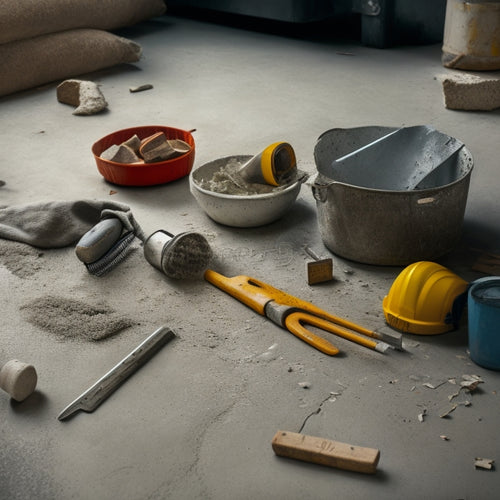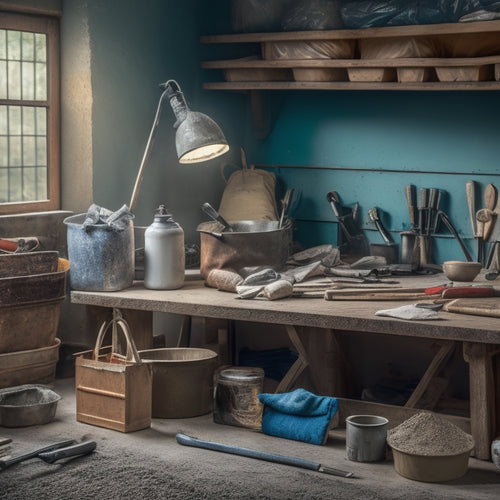
Why These Tools Are Crucial for Concrete Patio
Share
You're about to commence on a concrete patio project, and having the right tools is vital to achieving professional-looking results and avoiding costly rework. You'll need demolition tools like jackhammers and pry bars to remove existing concrete, cutting and shaping tools like circular saws and diamond blades to create precise cuts, and drilling and mixing techniques to guarantee a strong foundation. Additionally, safety gear like hard hats and steel-toed boots are important to protecting yourself on the job. With the right tools and techniques, you'll be well on your way to creating a stunning concrete patio - and exploring the following essential steps will help you bring your vision to life.
Key Takeaways
- These tools ensure precision and accuracy in concrete patio construction, preventing costly rework and ensuring project success.
- Proper use of demolition tools prevents damage to underlying structures, while cutting and shaping tools enable intricate designs and patterns.
- Drilling and mixing techniques with the right tools guarantee a strong and durable concrete finish, free from weak spots and porosity.
- Smoothing and finishing tools are essential for achieving a professional-looking finish, with the right techniques and tools delivering a smooth, even surface.
- Safety gear and measuring tools are crucial for protecting workers and ensuring accurate project execution, minimizing errors and maximizing results.
Demolition Tools for Concrete Removal
Demolition Tools for Concrete Removal
Three key demolition tools are essential for concrete removal: a jackhammer, a demolition hammer, and a pry bar. You'll use these tools to break apart and remove the old concrete patio.
Mastering jackhammer techniques is vital to efficient demolition. Hold the jackhammer with both hands, keeping your arms straight and your back straight. Apply gentle to moderate pressure, depending on the concrete's thickness. For thicker slabs, use a demolition hammer to break up the concrete before switching to a jackhammer.
Always prioritize demolition safety: wear protective gear, including gloves, safety glasses, and a dust mask. Demolition can be physically demanding, so take regular breaks to avoid fatigue.
A pry bar is handy for removing small sections of concrete or prying loose stubborn pieces. With these three tools and proper techniques, you'll be well-equipped to tackle your concrete removal project.
Remember to work methodically, following a pattern to avoid damaging underlying structures or pipes.
Cutting and Shaping Essentials
At least three cutting and shaping tools are essential for refining your concrete patio's design: a circular saw, a concrete grinder, and a diamond blade.
These tools allow you to achieve precise cuts and shapes, ensuring your patio's design is executed flawlessly. A circular saw is ideal for making straight cuts in your concrete, while a concrete grinder is used to smooth out rough edges and surfaces.
A diamond blade, on the other hand, is perfect for intricate cuts and molding techniques.
When using these tools, it's vital to make precise angle adjustments to achieve the desired shape.
You'll need to adjust the blade's angle to accommodate the specific design requirements of your patio. By doing so, you'll be able to create complex shapes and patterns, adding visual appeal to your concrete patio.
With these cutting and shaping tools, you'll have the precision and control needed to bring your design vision to life.
Drilling and Mixing Mastery
With your concrete patio's design refined through cutting and shaping, you're ready to move on to the vital steps of drilling and mixing.
Drilling techniques are essential to guarantee accurate placement of anchors, screws, or other fasteners. You'll need a drill bit specifically designed for concrete, such as a carbide-tipped or diamond-coated bit. Apply gentle to moderate pressure, depending on the type of drill and bit, to avoid damaging the surrounding concrete.
Next, you'll need to mix your concrete to the correct ratio. Mixing ratios vary depending on the type of concrete and intended use, but a general rule of thumb is a 1:2:3 ratio of cement to sand to aggregate.
Overmixing can lead to a weak and porous finish, so mix only until the ingredients are well combined. Use a mixing paddle or trowel to scrape the sides and bottom of the mixing container to guarantee all ingredients are incorporated.
Accurate drilling and mixing techniques are vital to a strong, durable, and long-lasting concrete patio.
Smoothing and Finishing Tools
Throughout the concrete patio construction process, you've reached the essential phase where precision and finesse come into play: smoothing and finishing. This stage demands attention to detail and the right tools to achieve the desired surface textures.
You'll need a range of smoothing and finishing tools to refine your patio's surface, including trowels, floats, and edgers.
Mastering trowel techniques is vital for achieving a smooth, even finish. You'll need to develop a feel for the concrete's consistency and adjust your strokes accordingly.
A bull float or fresno trowel is ideal for large, open areas, while a smaller, handheld trowel is better suited for edges and corners.
For a more textured finish, use a broom or a specialized texture mat to create the desired pattern.
Safety Gear for Patio Renovation
When renovating a concrete patio, you'll need to prioritize safety above all else.
You'll require protective eye wear to shield your eyes from debris and dust, steel-toed boots to prevent foot injuries, and hard hats to protect your head from falling objects.
Protective Eye Wear
Safety goggles or protective eyewear are an essential component of your safety gear arsenal when renovating a concrete patio. You're working with heavy machinery, power tools, and materials that can potentially cause eye injuries.
Without proper eye protection benefits, you're risking permanent damage to your vision.
When choosing eyewear, consider the type of hazards you'll face during the renovation process. If you'll be working with chemicals, look for goggles with a good seal to prevent splashes from entering the eyes.
For impact protection, opt for eyewear with a durable frame and shatter-resistant lenses.
Make sure the goggles fit comfortably and don't obstruct your peripheral vision. You'll be wearing them for extended periods, so comfort is vital.
ANSI-approved eyewear is a must, as it meets the highest safety standards.
Don't take shortcuts when it comes to your eye protection – invest in high-quality goggles that will provide reliable protection throughout your concrete patio renovation project.
Steel-Toed Boots Required
Your steel-toed boots are the first line of defense against heavy objects, tools, and equipment that can crush your feet during a concrete patio renovation. Without them, you're exposing yourself to serious injury, including broken bones, crushed toes, or even amputation.
Steel-toed boots provide unparalleled protection, thanks to their robust design and reinforced toe caps. The steel toed benefits are undeniable – they can withstand immense pressure and weight, giving you peace of mind as you work.
When choosing steel-toed boots, prioritize footwear durability. Look for boots made from high-quality materials, such as thick leather or heavy-duty synthetic materials. A sturdy sole and reinforced ankle support are also essential.
Don't compromise on comfort, either – a comfortable pair of boots will keep you focused on the task at hand. Remember, your safety is paramount, and steel-toed boots are a vital investment for any concrete patio renovation project.
Hard Hats Essential
Hard hats are a critical component of your personal protective equipment (PPE) arsenal during a concrete patio renovation. You're working with heavy materials, power tools, and equipment that can pose serious head injury risks. A hard hat is your first line of defense against falling objects, debris, and electrical hazards.
Make certain you choose a hard hat that meets the Occupational Safety and Health Administration's (OSHA) hard hat regulations, which require hard hats to withstand impacts of up to 20 feet.
When selecting a hard hat, consider the materials it's made of. Hard hats can be made from polyethylene, polycarbonate, or fiberglass.
Polyethylene hard hats are lightweight and resistant to scratches, while polycarbonate hard hats offer superior impact resistance. Fiberglass hard hats are a popular choice due to their durability and affordability.
Regardless of the material, make certain your hard hat is properly fitted and maintained to provide maximum protection. A well-maintained hard hat can mean the difference between a close call and a serious injury.
Don't take chances – wear a hard hat that meets hard hat regulations and is made from high-quality materials. Your safety depends on it.
Measuring and Marking Accuracy
Measuring and marking accuracy is essential to a successful concrete patio project, as even slight errors can lead to costly rework or a subpar finish.
When you're working with concrete, precision matters, and that's why investing in the right measuring tools and mastering effective marking techniques is vital.
To guarantee accuracy, you'll need:
- A high-quality tape measure or laser distance meter to take precise measurements
- A chalk line or spray paint to mark clear, straight lines
- A level and square to confirm your patio is perfectly aligned and plumb
With these tools and techniques at your disposal, you'll be able to achieve professional-grade results.
Power Saws for Precise Cuts
When you're working on a concrete patio, you'll need power saws that can accurately cut through concrete without compromising its integrity.
To achieve smooth edge finishing, you'll want to select saws with diamond-coated blades or specialized concrete-cutting attachments.
Cutting Through Concrete
Several power saws are designed to make precise cuts through concrete, and you'll need to choose the right one for your patio project. When it comes to cutting through concrete, you'll want to select a saw that can handle the task efficiently and effectively.
Concrete saws are specifically designed for this purpose, and they come in various types, including walk-behind saws, handheld saws, and ring saws. Each type has its own strengths and weaknesses, and the right choice will depend on the size and complexity of your project.
-
Use a walk-behind saw for larger projects that require more power and precision.
-
Handheld saws are ideal for smaller projects and offer more flexibility.
-
Ring saws are perfect for curved cuts and offer a high level of precision.
When choosing a saw, consider the blade type, horsepower, and cutting technique. Understanding the different cutting techniques, such as plunge cutting and free-hand cutting, will also help you achieve the desired results.
With the right saw and cutting technique, you'll be able to make precise cuts through concrete and achieve a professional-looking finish.
Smooth Edge Finishing
Precision is key when it comes to smooth edge finishing, and the right power saw can make all the difference. You need a saw that can deliver precise cuts, guaranteeing a clean and refined finish.
When working with concrete, you're not just cutting through a material, you're creating a surface that will be visible for years to come. That's why investing in a high-quality power saw is essential.
With the right power saw, you can achieve various edge treatment techniques that elevate the aesthetic of your concrete patio. From rounded edges to sharp, angular cuts, the possibilities are endless.
You can opt for aesthetic finishing options like bullnose, bevel, or radius edges, adding a touch of sophistication to your outdoor space. A power saw with adjustable depth control and a stable platform guarantees accurate cuts, giving you the confidence to take on complex projects.
Grinders for Surface Preparation
Preparing a concrete patio for resurfacing or refinishing requires a thorough surface preparation, and that's where grinders come into play.
You'll need a reliable grinder to remove old coatings, dirt, and oil spots, creating a smooth surface for your new finish. With the right grinder, you can achieve excellent results in concrete polishing techniques.
When choosing a grinder, consider the following factors:
-
Power and speed: A more powerful grinder with adjustable speed settings will help you tackle tough jobs efficiently.
-
Dust control: Look for a grinder with a built-in dust collection system or a compatible vacuum attachment to minimize mess and maximize safety.
-
Maintenance: Regularly inspect and replace worn-out parts, and follow grinder maintenance tips to extend the tool's lifespan and performance.
Frequently Asked Questions
How Often Should I Lubricate My Concrete-Cutting Tools?
You should lubricate your concrete-cutting tools after every 2-3 hours of use, and daily if you're working in harsh environments, using proper lubrication techniques to guarantee peak performance and extend tool maintenance.
Can I Use a Hammer Drill for Mixing Concrete?
When mixing concrete, you can use a hammer drill, but be aware that its benefits lie in speed, not thoroughness; employ proper mixing techniques, such as slow, consistent revolutions, to guarantee a strong, uniform mix.
What Is the Best Way to Store Leftover Concrete?
Like a master chef with ingredients, you'll wisely store leftover concrete in airtight containers or bags, keeping it fresh for the next project, and properly dispose of excess through concrete recycling or landfill drop-offs, minimizing waste.
Are Concrete Patio Renovations a Diy-Friendly Project?
When tackling a concrete patio renovation, you'll find it's a DIY-friendly project if you're willing to invest time in patio design planning and prioritize DIY safety, ensuring a successful outcome that meets your high standards.
How Long Does It Take for New Concrete to Fully Cure?
You might think you can rush the curing process, but don't; it takes around 28 days for new concrete to fully cure, achieving ideal concrete strength, and compromising on this timeline can lead to weakened structures and costly repairs down the line.
Conclusion
As you wrap up your concrete patio project, remember that "well begun is half done." Having the right tools from the start sets you up for success. From demolition to finishing, each tool plays an essential role in achieving a professional-looking result. Don't skimp on quality or skip vital tools – it'll cost you more in the long run. Invest in the right equipment, and you'll be enjoying your new patio in no time.
Related Posts
-

10 Best Tools for Sealed Concrete Flooring on Budget
When starting on a sealed concrete flooring project on a budget, you'll need to prioritize essential tools without sa...
-

Top 10 Concrete Repair Tools for Small Fixes
You'll need the right tools to tackle small concrete repairs efficiently and effectively. When it comes to small fixe...
-

10 Must-Have Tools for Small Concrete Projects
When tackling small concrete projects, you'll need a range of essential tools to achieve professional-grade results. ...


